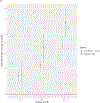Identification of novel risk loci, causal insights, and heritable risk for Parkinson's disease: a meta-analysis of genome-wide association studies
- PMID: 31701892
- PMCID: PMC8422160
- DOI: 10.1016/S1474-4422(19)30320-5
Identification of novel risk loci, causal insights, and heritable risk for Parkinson's disease: a meta-analysis of genome-wide association studies
Abstract
Background: Genome-wide association studies (GWAS) in Parkinson's disease have increased the scope of biological knowledge about the disease over the past decade. We aimed to use the largest aggregate of GWAS data to identify novel risk loci and gain further insight into the causes of Parkinson's disease.
Methods: We did a meta-analysis of 17 datasets from Parkinson's disease GWAS available from European ancestry samples to nominate novel loci for disease risk. These datasets incorporated all available data. We then used these data to estimate heritable risk and develop predictive models of this heritability. We also used large gene expression and methylation resources to examine possible functional consequences as well as tissue, cell type, and biological pathway enrichments for the identified risk factors. Additionally, we examined shared genetic risk between Parkinson's disease and other phenotypes of interest via genetic correlations followed by Mendelian randomisation.
Findings: Between Oct 1, 2017, and Aug 9, 2018, we analysed 7·8 million single nucleotide polymorphisms in 37 688 cases, 18 618 UK Biobank proxy-cases (ie, individuals who do not have Parkinson's disease but have a first degree relative that does), and 1·4 million controls. We identified 90 independent genome-wide significant risk signals across 78 genomic regions, including 38 novel independent risk signals in 37 loci. These 90 variants explained 16-36% of the heritable risk of Parkinson's disease depending on prevalence. Integrating methylation and expression data within a Mendelian randomisation framework identified putatively associated genes at 70 risk signals underlying GWAS loci for follow-up functional studies. Tissue-specific expression enrichment analyses suggested Parkinson's disease loci were heavily brain-enriched, with specific neuronal cell types being implicated from single cell data. We found significant genetic correlations with brain volumes (false discovery rate-adjusted p=0·0035 for intracranial volume, p=0·024 for putamen volume), smoking status (p=0·024), and educational attainment (p=0·038). Mendelian randomisation between cognitive performance and Parkinson's disease risk showed a robust association (p=8·00 × 10-7).
Interpretation: These data provide the most comprehensive survey of genetic risk within Parkinson's disease to date, to the best of our knowledge, by revealing many additional Parkinson's disease risk loci, providing a biological context for these risk factors, and showing that a considerable genetic component of this disease remains unidentified. These associations derived from European ancestry datasets will need to be followed-up with more diverse data.
Funding: The National Institute on Aging at the National Institutes of Health (USA), The Michael J Fox Foundation, and The Parkinson's Foundation (see appendix for full list of funding sources).
Copyright © 2019 Elsevier Ltd. All rights reserved.
Conflict of interest statement
All others have no disclosures or potential conflicts of interest.
Figures




Comment in
-
Challenges in disentangling the genetic background of Parkinson's disease.Lancet Neurol. 2019 Dec;18(12):1069-1070. doi: 10.1016/S1474-4422(19)30387-4. Lancet Neurol. 2019. PMID: 31701887 No abstract available.
References
-
- International Parkinson Disease Genomics Consortium, Nalls MA, Plagnol V, Hernandez DG, Sharma M, Sheerin U-M, et al.Imputation of sequence variants for identification of genetic risks for Parkinson’s disease: a meta-analysis of genome-wide association studies. Lancet. 2011February19;377(9766):641–9. - PMC - PubMed
-
- Dorsey ER, Constantinescu R, Thompson JP, Biglan KM, Holloway RG, Kieburtz K, et al.Projected number of people with Parkinson disease in the most populous nations, 2005 through 2030. Neurology. 2007January30;68(5):384–6. - PubMed
Publication types
MeSH terms
Grants and funding
- MR/L501542/1/MRC_/Medical Research Council/United Kingdom
- H-1703/PUK_/Parkinson's UK/United Kingdom
- G0701075/MRC_/Medical Research Council/United Kingdom
- G1100643/MRC_/Medical Research Council/United Kingdom
- K-1501/PUK_/Parkinson's UK/United Kingdom
- RF1 AG058476/AG/NIA NIH HHS/United States
- MR/N026004/1/MRC_/Medical Research Council/United Kingdom
- G0901254/MRC_/Medical Research Council/United Kingdom
- G0700943/MRC_/Medical Research Council/United Kingdom
- MR/K01417X/1/MRC_/Medical Research Council/United Kingdom
- G-0907/PUK_/Parkinson's UK/United Kingdom
- Z99 AG999999/ImNIH/Intramural NIH HHS/United States
LinkOut - more resources
Full Text Sources
Other Literature Sources
Medical
Miscellaneous

